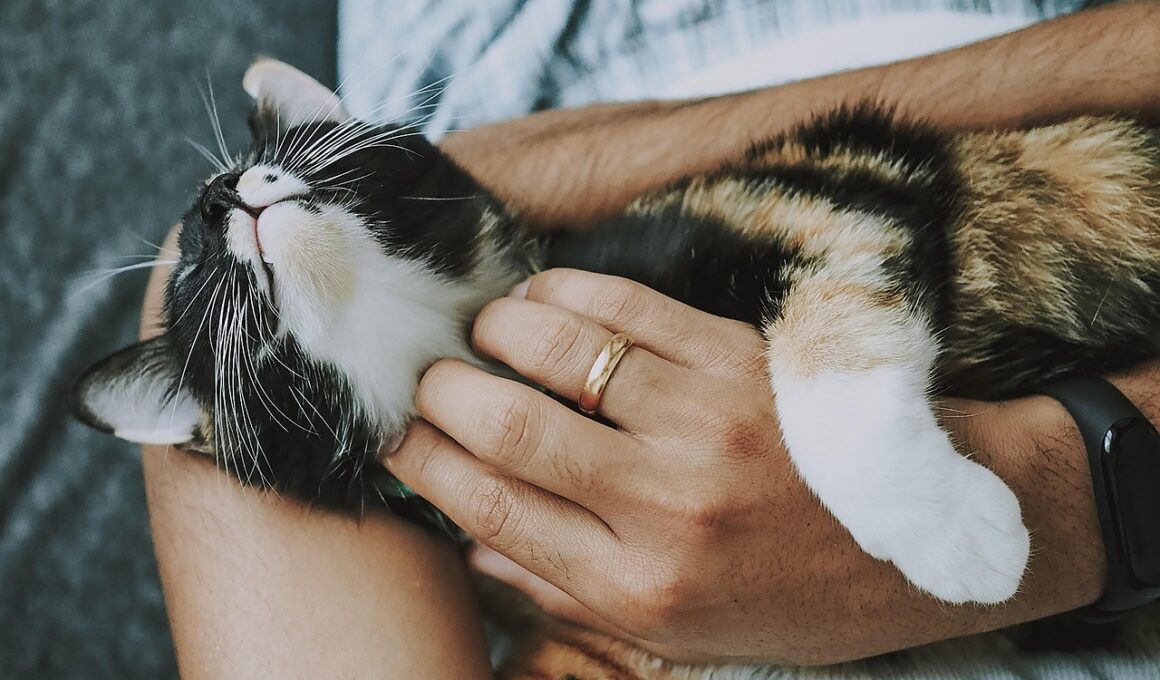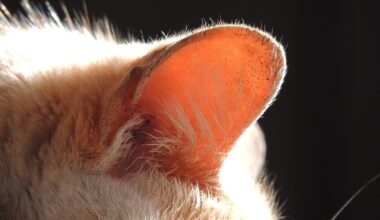What to Expect When Adopting a Rescued Cat
Adopting a rescued cat is a rewarding experience filled with both excitement and responsibility. The process begins with research about the specific breed or characteristics of the cat you wish to adopt. Each rescued cat has its own personality and past experiences that shape its behavior. Connecting with local shelters or rescue groups can provide valuable insights and options. Furthermore, you’re encouraged to meet the cat in their environment; observe how they interact with staff and other animals. Understanding the cat’s medical history is also essential. This background will help you prepare for potential health issues or special needs. Adoption usually involves filling out an application, which may include questions regarding your home environment and previous pet experiences. Be honest as this helps shelters match you with the right cat. Once your application is approved, a home check might happen. This is a chance for the shelter to evaluate your living conditions, ensuring they are safe for the cat. Costs associated with adoption may also include initial medical treatments, vaccinations, and spaying or neutering. Finally, adopting a cat means providing a lifelong commitment to love and care.
After your adoption of a rescued cat, the next stage is introducing the new feline to your home. Cats thrive on familiarity, so it’s crucial to create a welcoming space. Start by providing a quiet area for the cat to explore, equipped with essentials like a litter box, food, water, and a comfortable bed. Gradually allow your new friend to explore other rooms, but monitor their movements to ensure they feel safe. It’s important to give the cat time to adjust, which may take anywhere from a few days to several weeks, depending on their background. Establishing a routine, including feeding schedules and playtime, can help reduce anxiety. Patience is key; each cat adjusts differently. Keep interaction gentle and slow, allowing them to approach you when they’re ready. Consider enrichment activities to engage their curiosity and help them feel at home. Toys like feather wands or laser pointers can be beneficial in building trust. Also, providing a high perch for them to observe their surroundings can be comforting. Lastly, ensure all windows and doors are secured for safety, preventing unwanted escapes during this adjustment period.
Understanding Behavioral Changes
As your rescued cat settles in, be aware of possible behavioral changes. Many rescued cats might exhibit signs of stress, such as hiding or excessive vocalization. Understanding these behaviors is essential for adjusting expectations and ensuring your pet feels secure. Some cats may take longer to warm up, so be prepared to exercise patience. Recognize that past traumas can shape how a cat interacts with humans and their environment. They might be fearful of sudden movements or loud noises. The use of calming products, such as pheromone diffusers, can create a soothing environment. Additionally, consider spending time on bonding activities, like gentle petting or soft conversations. Treats can also encourage trust and positive interactions. Responsiveness to their body language is critical; observe their ears, tail, and posture to gauge their comfort level. Gradually introducing new sounds, experiences, and people can help them acclimate more effectively. Furthermore, avoid forcing them into interactions. Let the cat dictate their pace. Over time, you will notice more confident behaviors emerge, such as playful antics or seeking your companionship. Building a lasting bond is worth the initial effort and can create a loving relationship.
Nutrition plays a vital role in successfully adopting a rescued cat. Selecting the right diet contributes to the cat’s overall health and happiness. When transitioning to new food, do it gradually, mixing their previous diet with the new to avoid digestive upset. Cats require a balanced diet rich in high-quality proteins, essential fatty acids, and appropriate vitamins. Consult your veterinarian for recommendations tailored to your cat’s age, weight, and health status. For instance, senior cats may require specialized diets to support their specific needs. Pay close attention to portion sizes; overfeeding can lead to obesity, a common issue among indoor cats. Regular feeding schedules help establish routine and structure. Provide fresh water daily, as hydration is crucial for their wellbeing. If your rescued cat has special dietary needs, discuss this with your vet to find the best solutions. Additionally, monitor your cat’s weight after adoption and encourage physical activity through playtime. Engaging them in active games not only strengthens your bond but also maintains their health. By focusing on nutrition and proper care, you can help your new furry friend thrive in their forever home.
Regular Vet Visits and Health Checks
Regular veterinary check-ups are essential for ensuring the long-term health of your rescued cat. Schedule an initial visit shortly after adoption for a thorough evaluation. The vet can assess their health, administer any needed vaccinations, and discuss preventive care options. Many rescued cats may arrive with unknown medical histories, so comprehensive examinations are vital. Moreover, neutering or spaying should be performed if not already done. This practice can significantly reduce health risks and unwanted behaviors. During vet visits, it’s also crucial to discuss topics like dental care and parasite prevention. Dental health is often overlooked but plays a significant role in a cat’s overall wellbeing. The vet may suggest products or methods to help maintain healthy teeth. Additionally, flea and tick prevention is necessary, especially if your cat will venture outdoors. Monitoring for any changes in behavior or dietary habits can provide important clues about health issues. Regular vet visits should ideally include annual check-ups for adult cats and bi-annual for seniors. Building a relationship with your veterinarian fosters teamwork in ensuring your furry companion remains happy and healthy.
Socializing is a key aspect of helping your newly adopted cat thrive. While some cats may naturally be more social, others might take longer to warm up. It’s important to understand their individual needs and adjust your approach accordingly. Spend quality time engaging in gentle activities that promote bonding, like quiet play sessions or simply being together in a calm space. Providing a variety of toys can stimulate their curiosity and keep them active, fostering a positive environment. Consider creating safe spaces and hiding spots where your cat can retreat when feeling overwhelmed or scared. Cat trees or tunnels offer them opportunities for exploration and comfort. Gradually introducing new experiences, such as petting or grooming sessions, can help enhance trust. Always follow your cat’s cues when they exhibit preference for interaction or solitude. If possible, network with other pet families or adopt another cat for companionship. Cats often enjoy the company of fellow felines, reducing feelings of loneliness. By prioritizing socialization, patience and empathy transform your new pet into a loving member of your family, leading to a fulfilling relationship.
Conclusion: Embrace Your New Journey
In conclusion, adopting a rescued cat is not just about providing a home; it’s embarking on a meaningful journey filled with love, patience, and understanding. Every cat comes with a unique history and personality, requiring time to adapt to a new environment. By following the outlined steps, new cat owners can ensure a smooth transition, creating a nurturing space for their furry friend. Remember to prioritize their physical and emotional health by scheduling regular vet visits and maintaining a balanced diet. Bonding takes time, but the rewards are immeasurable; you will create lasting memories together. Engaging in play, socialization, and providing comfort will foster trust, making your pet feel truly at home. As you navigate challenges like behavioral changes and adjustment periods, remain patient and observant. Your rescued cat deserves love and care, and by investing in this relationship, you will witness transformations. Lastly, consider sharing your journey with friends or fellow pet owners. Inspire others to adopt and help other animals in need. Together, let’s create a kinder world for rescued cats, one heartwarming story at a time.


